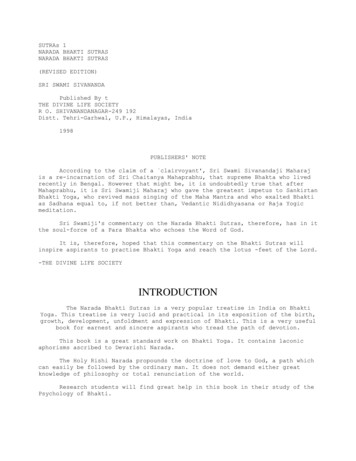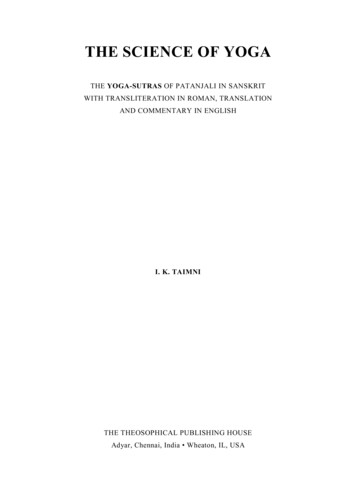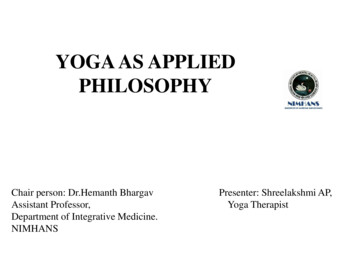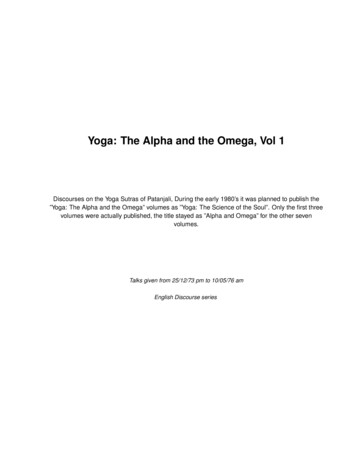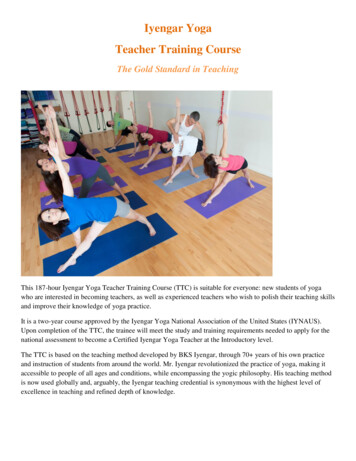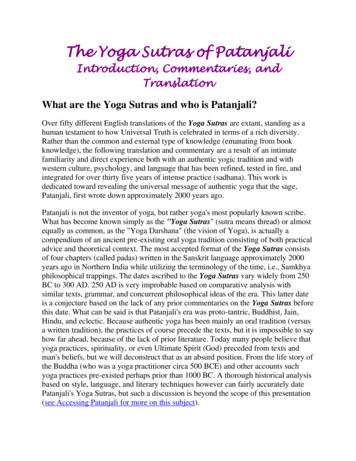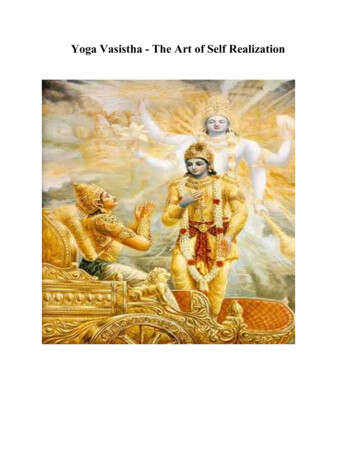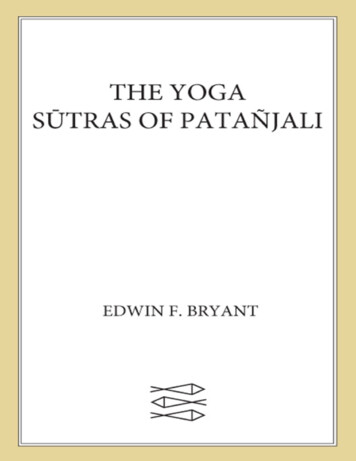
Transcription
THE YOGA SŪTRAS OF PATAÑJALIA New Edition, Translation, and CommentaryWITH INSIGHTS FROM THETRADITIONAL COMMENTATORSEDWIN F. BRYANTNorth Point PressA division of Farrar, Straus and GirouxNew York
The author and publisher have provided this e-book to you for yourpersonal use only. You may not make this e-book publicly available inany way. Copyright infringement is against the law. If you believethe copy of this e-book you are reading infringes on the p://us.macmillanusa.com/piracy.
To my daughter, MohiniAnd to all teachers of yoga, that Patañjali’s Sūtras may inform andinspire their teachings
CONTENTSTitle PageCopyright NoticeDedicationForeword by B.K.S. IyengarSanskrit Pronunciation GuideThe History of YogaYoga Prior to PatañjaliThe Vedic PeriodYoga in the UpaniṣadsYoga in the MahābhārataYoga and SāṅkhyaPatañjali’s YogaPatañjali and the Six Schools of Indian PhilosophyThe Yoga Sūtras as a TextThe Commentaries on the Yoga SūtrasThe Subject Matter of the Yoga SūtrasThe Dualism of YogaThe Sāṅkhya Metaphysics of the TextThe Goals of YogaThe Eight Limbs of YogaThe Present Translation and CommentaryCHAPTER I:MEDITATIVE ABSORPTIONCHAPTER II: PRACTICECHAPTER III: MYSTIC POWERSCHAPTER IV: ABSOLUTE INDEPENDENCEConcluding Reflections
Chapter SummariesAppendix: Devanāgarī, Transliteration, and Translation of SūtrasNotesBibliographyGlossary of Sanskrit Terms and NamesWord IndexAcknowledgmentsPraise for The Yoga Sūtras of PatañjaliAbout the AuthorAlso by Edwin F. BryantCopyright
FOREWORDby B.K.S. IyengarI congratulate you on your lucid commentary on the Yoga Sūtras ofPatañjali. I have appreciated your commentary quoting the traditionalcommentators Vyāsa, Vācaspati Miśra, Śaṅkara, Bhoja Rāja,Vijñānabhikṣu, and Hariharānanda, and it reads well. You havepresented it in simple and fluent language, which I am sure will be easilyunderstandable to readers. As you are dedicating it to the teachers ofyoga, I am sure your book will provide the readers with plenty ofknowledge so that they may grasp the philosophy behind the subject andmove toward the higher aspects of life in their sādhana (practice).Pātañjala Yoga is a practical subject and not a discursive one. As eachindividual is electrically alive and dynamic, so yoga is a living, dynamicforce in life. In order to savor its essence, one needs a religiouslyattentive dynamic practice done with awareness and absorption. The lifeof man is not only the conjunction of prakṛti (the sheaths of the body)and puruṣa (the soul), but also a combination of these two. Yoga is ameans to utilizing the conjunction of prakṛti and puruṣa for freedom andbeatitude (mokṣa), as the two are interwoven and interrelated.Patañjali explains the practice of kriyā-yoga in sūtra I of the sādhanapāda, repeating the same ingredients as are found in the niyamadisciplines, namely, tapas, svādhyāya, and Īśvara-praṇidhāna (discipline,self-study and devotion to God). This three-tiered definition clearlyindicates the paths of karma, jñāna, and bhakti. Though Patañjali advisesbhakti in the beginning of the text in I.23, I consider the disciplines ofyama and niyama (II.30–45) as corresponding to karmamarga (the path ofaction); āsana, prāṇāyāma, and pratyāhāra (II.46–55) as corresponding tojñāna-marga (the path of knowledge); and dhāraṇā, dhyāna, and samādhi(saṁyama, III.1–4) as corresponding to bhakti marga (the path ofdevotion).
Prakṛti and puruṣa being interwoven and interrelated, the practitionersof yoga have to understand this relationship clearly and performsvādhyāya in the form of āsana, prāṇāyāma, and pratyāhāra. Svā means“self” and adhyāya means “study.” These three aspects of Patañjala Yogalead the sādhaka (practitioner) to understand himself or herself from theskin to the self. Hence, this guides one on the path of jñāna. Dhāraṇā,dhyāna, and samādhi being the effect of jñana earned through thepractices of āsana, prāṇāyāma, and pratyāhāra along with yama andniyama, then lead the sādhaka toward the path of bhakti. Bhakti is thesummum bonum of Pātañjala Yoga. But if the sādhaka abuses thesādhana with selfish motives, he or she ends up with only the joys ofsensual pleasure (bhoga).As yoga is a lively subject, interpretations of the sūtras may varyaccording to dharma, lakṣana, and avastha pariṇāma (character, qualities,and conditions) in sādhana (III.13). Therefore, I differ from thetraditional commentators on two things. The first pertains to the effectsof āsana: tato dvandvānabhighātāḥ (II.48). The entire text speaks of theintelligence of nature and the intelligence of the self. I understand thatthe perfection of āsana brings unity between the various sheaths of thebody and the self (puruṣa), which Lord Kṛṣna calls kṣetra-kṣetrajña yoga inthe Bhagavad Gītā (XIII.1ff). Hence, perfection in āsana means a divineunion of prakṛti with puruṣa.The practice of āsanas develops sattva guṇa, sublimating the guṇas ofrajas and tamas. The aim of āsanas is to make the prāṇa (cosmicuniversal force) move concurrently with the prajñā (insight) of the selfon its frontier. This means to make the awareness of the self (sāsmitā)move and cover the entire body (II.19) so that the mechanisms of natureare sublimated and the intelligence (prajñā) of the self engulfs the bodywith its śakti.The second point pertains to the virāma pratyaya of verse I.18 (virāmapratyayābhyāsa-pūrvaḥ saṁskāra-śeṣo ‘nyaḥ—the other samādhi ispreceded by cultivating the determination to terminate [all thoughts].[In this state] only latent impressions remain). Patañjali himself does notcall this other state asamprajñāta-samādhi (I.46). He has said that it ispart of sabīja-samādhi (I.46). The various commentators infer this state tobe asamprajñāta, and this may be because Patañjali mentions
samprajñāta-samādhi in the preceding sūtra. For me, this sūtra is referringto a consolidating state of samprajñāta-samādhi, after attaining which theyogī can move toward asamprajñāta (nirbīja) samādhi. Hence, this stateacts as the intermediary state for nirbīja-samādhi. Just as pratyāhāra inaṣṭāṇga-yoga (II.54) is a consolidating stage, where one needs tointegrate the external sheath (bahiraṅga) with the innermost sheath(antaraṅga), so is the case with the stage of virāma pratyaya, for whichPatañjali has not coined any term. It is a consolidating stage of sabījasamādhi, after which the yogī naturally moves toward nirbīja-samādhi.For me, the state of pratyāhāra in aṣṭāṅga-yoga and virāma-pratyaya insamādhi are the touchstones in understanding the purity, clarity, andmaturity of prajñā, intelligence. When this illuminative and luminousintelligence takes place, the union of prakṛti with puruṣa happens (sattvapuruṣayoḥ śuddhi-samye kaivalyam iti III.56*). Even in this pratyāhārastate of aṣṭāṇga-yoga and virāma-pratyaya state in samādhi, if one neglectsśraddhā, vīrya, smṛti, samādhi-prajñā (faith, vigor, memory, and theinsight of samādhi, the four legs of yoga in I.20), then, even if one hasreached the zenith, one is bound to become a yoga-bhraṣṭa, a fallen yogī.Therefore, the practice of pratyāhāra in aṣṭāṅga yoga or virāma-pratyayain samādhi is to be performed with these four legs of yoga so as tomaintain and retain that state of seasoned wisdom (ṛtambharā prajñā,I.48) that consecrates citi-śakti (the power of puruṣa). It is thiscombination only that leads the yogī toward the highest state in bhaktimarga—the śaraṇāgati-mārga—total dependence on Īśvara, God. This ishow I understand and practice the aṣṭāṅga-yoga of sage Patañjali.Having expressed my feelings, I am sure your good work andexpressions, using the attributes of all the earlier commentators on theYoga Sūtras, will turn out as a study book for hundreds and hundreds ofstudents who have embraced the subject in the West in knowing thelight of that hidden illuminative intelligence on the inner self, the ātman,and making that light surface and active in their sādhana, which willhelp their fellow beings experience this unalloyed and untainted blisswith its stream of virtuous (śīlatā) wisdom.With all my best wishes, I am sure this volume will benefit yogasādhakas and spiritual seekers throughout the world.Pune, December 5, 2007
*Editor’s note: B.K.S. Iyengar accepts fifty-six verses in the third pada where other commentatorsaccept fifty-five.
SANSKRIT PRONUNCIATION GUIDEDIACRITICS USED IN THIS TRANSLATION:ā ī ū ṛ ḷ ḥ ṁ ṅ ñ ṇ ṭ ḍ ś ṣThe following pronunciation guide attempts to give approximateequivalents in English to the Sanskrit sounds used in this text.VOWELSSanskrit vowels have both short forms and lengthened forms (the latterare transliterated by a line over the vowel—ā, ī, ū), as well as a retroflexṛ sound articulated by curling the tongue farther back onto the roof ofthe mouth than for the English r. Other Sanskrit vowels alien to Englishare noted below. Vowels are listed in Sanskrit in the followingtraditional order (according to their locus of articulation, beginning fromthe back of the throat to the front of the mouth):aas in “but”āas in “tar”; held twice as long as short aias in “bit”īas in “week”; held twice as long as short iuas in “bush”ūas in “fool”; held twice as long as short uṛas in “rim”ḷno English equivalent; approximated by l followed by ṛ, aboveeas in “they”aias in “aisle”oas in “go”
auas in “vow”ḥ (visarga)a final “h” sound that echoes the preceding vowel slightly;as in “aha” for aḥṁ (anusvāra)a nasal sound pronounced like mm, but influencedaccording to whatever consonant follows, as in “bingo,” “punch”CONSONANTSSanskrit consonants have both aspirated forms (kh, gh, ch, jh, and so on)and unaspirated forms (k, g, c, j, and so on); the former involvearticulating the consonant accompanied by a slight expulsion of air.There is also a set of retroflexes (transliterated with a dot beneath them—ṭ, ḍ, ṭh, ḍh, ṇ, ṣ), which have no precise English equivalents, and theseinvolve curling the tongue farther back onto the roof of the mouth thanfor the English dentals. Sanskrit dentals (t, d, th, dh) are articulated withthe tongue touching the teeth, slightly farther forward than for theirEnglish equivalents. The consonants are listed in Sanskrit in thefollowing traditional order (according to their locus of articulation,beginning from the back of the throat to the front of the mouth):kas in “pick”khas in “Eckhart”gas in “gate”ghas in “dig-hard”ṅas in “sing”cas in “charm”chas in “staunch-heart”jas in “jog”jhas in “hedgehog”ñas in “canyon”ṭas in “tub,” but with the tongue curled farther back
ṭhas in “light-heart,” but with the tongue curled farther backḍas in “dove,” but with the tongue curled farther backḍhas in “red-hot,” but with the tongue curled farther backṇas in “tint,” but with the tongue touching the teethtas in “tub,” but with the tongue touching the teeththas in “light-heart,” but with the tongue touching the teethdas in “dove,” but with the tongue touching the teethdhas in “red-hot,” but with the tongue touching the teethnas in “no,” but with the tongue touching the teethpas in “pin”phas in “uphill”bas in “bin”bhas in “rub-hard”mas in “mum”yas in “yellow”ras in “run”las in “love”vas in “vine”śas in “shove”ṣas in “crashed,” but with the tongue curled farther backsas in “such”has in “hope”
THE HISTORY OF YOGAEveryone by now has heard of yoga, and, indeed, with millions ofAmericans in some form or fashion practicing āsana, the physical aspectof yoga, the teaching and practice of yoga, at least in the aspect oftechniques of body poses and stretches, are now thoroughly mainstreamactivities on the Western cultural landscape. Yoga has popularly beentranslated as “union with the divine”1 and may refer to a number ofdifferent spiritual systems. The Bhagavad Gītā, for example, discusses anumber of practices that have been termed yoga in popular literature:karma-yoga (buddhi-yoga), the path of action; jñāna-yoga (sāṅkhya-yoga),the path of knowledge; bhakti-yoga, the path of devotion; and dhyānayoga, the path of silent meditation (which is the subject of Patañjali’stext),2 and terms such as tantra-yoga, siddha-yoga, nāḍa-yoga, and soforth are now common in alternative spiritualities in the West. Typically,however, when the word yoga is used by itself without any qualification,it refers to the path of meditation, particularly as outlined in the YogaSūtras—the Aphorisms on Yoga—and the term yogī, a practitioner of thistype of meditational yoga.Patañjali was the compiler of the Yoga Sūtras, one of the ancienttreatises on Indic philosophy that eventually came to be regarded as oneof the six classical schools of Indian philosophy. He presented a teachingthat focuses on realization of the puruṣa—the term favored by the Yogaschool3 to refer to the innermost conscious self, loosely equivalent to thesoul in Western Greco-Abrahamic traditions. The practice of yogaemerged from post-Vedic India as perhaps its most importantdevelopment and has exerted immense influence over the philosophicaldiscussions and religious practices of what has come to be known asmainstream Hinduism, both in its dominant forms in India and in itsmost common exported and repackaged forms visible in the West.Accordingly, Patañjali’s Yoga Sūtras is one of the most importantclassical texts in Hinduism and thus a classic of Eastern, and thereforeworld, thought. Along with the Bhagavad Gītā, it is the text that has
received the most attention and interest outside of India. I might addhere that Patañjali’s Yoga Sūtras is not an overtly sectarian text in thesense of prioritizing a specific deity or promoting a particular type ofworship as is the case with many Hindu scriptures, including theBhagavad Gītā. Therefore, as a template, it can be and has beenappropriated and reconfigured by followers of different schools andtraditions throughout Indian religious history4 and certainly continues tolend itself to such appropriations, most recently in nonreligious contextsof the West.In its exported manifestation, yoga has tended to focus on the physicalaspect of the system of yoga, the āsanas, or stretching poses and postures,which most Western adherents of yoga practice in order to stay trim,supple, and healthy. Patañjali himself, however, pays minimal attentionto the āsanas, which are the third stage of the eight stages, or limbs, ofyoga, and focuses primarily on meditation and various stages ofconcentration of the mind.There are references to awareness of yogīs on the Western landscape asearly as Greek classical sources, Alexander being perhaps the mostnotorious early Westener to be fascinated with Indian ascetics. Its initialintroduction to the West in modern times was by Vivekānanda at the endof the nineteenth century. More recently, generic yoga—particularly asāsanas, postures, but also as a meditative technique leading to samādhi,enlightenment—was popularized in the West by a number of influentialHindu teachers of yoga in the 1960s, most of whom came from twolineages: Sivananda (1887–1963) and Krishnamāchārya (1888–1989).Sivananda was a renunciant and his ashram tradition was transplantedby his disciples Vishnudevananda (1927–1993), Satchidananda (1914–2002), and Chinmayananda (1916–1993), each of whom founded hisown independent mission in the West (the Sivananda Yoga VedantaCentres, the Integral Yoga Institute, and the Chinmaya Mission,respectively). Krishnamāchārya’s three principal disciples took hisemphasis on the practice of āsana in their own direction: K. Pattabhi Jois(1915– ) continued to promote his version of astāṅga-vinyāsa-yoga;Krishnamāchārya’s son, T.K.V. Desikachar (1938– ), developed viniyoga;and—perhaps most influential of all—Krishnamāchārya’s brother-in-law,B.K.S. Iyengar (1918– ) established the Iyengar method. Almost all yoga
teachers trace their lineage to such masters, and the more serious amongsuch teachers or practitioners of yoga will have a valued copy of theYoga Sūtras.YOGA PRIOR TO PATAÑJALIThe Vedic PeriodIn terms of Yoga’s earliest origins, the Vedic period is the earliest era inSouth Asia for which we have written records, and it provides the matrixfrom which (or, more typically, against which) later religious,philosophical, and spiritual expressions such as Yoga evolved in India, atleast in the north of the subcontinent. We do not wish to invest anyfurther energy into the ongoing debate over whether the Vedic-speakingpeoples (Indo-Aryans5) were originally indigenous to the Indiansubcontinent or Indo-European intruders from an external point of origin(for which, see Bryant 2001 and 2005), except to note the corollaries ofthese two positions on the protohistory of Yoga. Those accepting anexternal point of origin for the Vedic-speaking peoples tend to hold thatYoga, both as practice and philosophy, was originally pre-Vedic (andtherefore non-Vedic) and indigenous to the subcontinent. From thisperspective, since there is no explicit reference to yogic practices andbeliefs in the earliest Vedic texts, their emergence in subsequent Vedicliterature such as the Upaniṣads6 points to a later period when the Vedicpeople had long settled and absorbed themselves into the preexistingpopulations of the Indian subcontinent. In this process, they establishedtheir own Vedic rituals as the mainstream “high” religious activity of theday, and also eventually absorbed many non-Vedic religious elementsfrom the indigenous peoples, such as Yoga philosophy and practice.Those challenging the thesis of external origins for the original Vedicspeaking peoples tend to prefer to see both Vedic ritualism and yogicpractices as parallel internal developments evolving within Vedic- (IndoAryan-) speaking communities indigenous to the subcontinent. It cancertainly be argued that the germs of yogic thought can be found inembryonic form in the (middle period) Vedic literatures themselves, theĀraṇyakas and Brāhmaṇa texts. Alternatively, there is little that can
discount the possibility that Yoga emerged outside Vedic orthodoxy butnonetheless within Indo-Aryan-speaking communities. (And, of course,one can combine components of these two positions and argue for theVedic or Indo-Aryan origins of Yoga but still hold that the Indo-Aryanswere nonetheless originally immigrants into the subcontinent.) What allthese positions have in common, and where our own discussion of theearly history of Yoga will commence, is that Yoga evolves on theperiphery of Vedic religiosity and beyond the parameters of mainstreamVedic orthopraxy. Yoga is clearly in tension with Vedic ritualism,discussed below, and its goals are in stark and explicit opposition to it(for example, Yoga Sūtras I.15–16).Before considering the early literary history of Yoga, however, wemust note that the arguments above are all primarily deduced from thefields of linguistics and philology. Archaeology has revealed the remainsof an enormous and sophisticated ancient civilization, the Indus Valleycivilization, covering modern-day northwest India and Pakistan, datingfrom circa 3000 to 1900 B.C.E. Mention must be made, when consideringthe earliest origins of Yoga, to seals found in Indus Valley sites withrepresentations of figures seated in a clear yogic posture. The mostfamous figure is seated with arms extended and resting on the knees in aclassical meditative posture.7 This evidence suggests that, irrespective ofits literary origins, Yoga has been practiced on the Indian subcontinentfor well over four thousand years.Like other Old World cultures, the dominant religious expression inthe early Vedic period within which Yoga emerges is that of thesacrificial cult wherein animals and other items are offered to variousgods through the medium of fire for the purposes of obtaining worldlyboons—offspring, cattle, victory over enemies, etc. A genre of texts, theBrāhmaṇas, describe the ritualistic minutiae of a wide variety ofsacrifices, both domestic and public, each one specific to the attainmentof particular goals. While the intricacies of the Vedic sacrificial rite mayseem alien to our modern worldviews and practices, the mentality thatsupported it—that of attempting to manipulate the external physicalenvironment for the purpose of enjoying the pleasures of the materialworld through the medium of the sensual body—has remained constantthroughout human history. It is for this reason that the post-Vedic
reactions to this type of mentality, in the form of developments such asthe various systems of yoga, remain perennially relevant to the humancondition.Yoga in the UpaniṣadsThere is evidence as early as the oldest Vedic text, the Ṛg Veda, thatthere were yogī-like ascetics on the margins of the Vedic landscape.8However, it is in the late Vedic age, marked by the fertile speculationsexpressed in a genre of texts called the Upaniṣads, that practices that canbe clearly related to classical yoga are first articulated in literarysources.9 The Upaniṣads reveal a clear shift in focus away from thesacrificial rite, which is relegated to an inferior type of religiosity,replacing it with an interest in philosophical and mystical discourse,particularly the quest for the ultimate, underlying reality underpinningthe external world, Brahman, localized in living beings as ātman.10 TheMuṇḍaka Upaniṣad (I.2. 7–11) calls the performers of sacrifice “deluded”and “ignorant,” however learned and competent they may posture to be,because the boons and fruits gained from the sacrifice—from themanipulation of one’s external environment, to use a more modernframe of reference—are temporary. When they expire, one finds oneselffrustrated once more. The Gītā, too, calls the Vedic ritualists “lessintelligent,” since any boons accruing from such materialism do notsolve the ultimate problems of life—human suffering inherent in thecycle of birth and death (II.42–45). A move toward understanding higherand more ultimate truths of reality is the prime feature of the Upaniṣads.Although the Upaniṣads are especially concerned with jñāna, orunderstanding Brahman, the Absolute Truth, through the cultivation ofknowledge, there are also several unmistakable references to a techniquefor realizing Brahman (in its localized aspect of ātman) called yoga,which are clearly drawn from the same general body of related practicesas those articulated by Patañjali.11 As with the Upaniṣads in general, wedo not find a systematic philosophy here, but mysticopoetic utterances,albeit profound in content. The Kaṭha Upaniṣad states:When the control of the senses is fixed, that is Yoga, so people say.For then, a person is free from distraction. Yoga is the “becoming,”
and the “ceasing.”12 Not by words, not by the mind, not by sight,can he [the self] be grasped; how else can he be perceived except bysaying: “he is!” For one who perceives him as he really is, his realnature becomes manifest. When all desires lurking in the heart areremoved, then a mortal person becomes immortal, and attainsBrahman in this world. When the knots in the heart that bind one tothis world are all cut, then a mortal becomes an immortal, such isthe teachings A puruṣa [ātman or soul] the size of a thumb dwellsalways in the hearts of men. One should extricate him withdetermination like a reed from muñja grass. One should know himas resplendent and immortal. Thus, when Naciketas had receivedthis knowledge and the complete rules of yoga from Death, heattained Brahman; he became free of disease and death. So, too, willothers who know these teachings about the self. (VI.11–18)The Śvetāśvatara Upaniṣad gets a little more specific about the actualtechnique of yoga practice:When he holds the body steady, with the three sections erect, andwithdraws the senses into his heart with the mind, a wise personwill cross over all the frightening rivers [of embodied existence] bymeans of the boat of Brahman. His breathing restrained here [withinthe body], and his energy under control, he should breathe throughone nostril when his breath is depleted. A wise person shouldcontrol the mind, just as one would a wagon yoked to unrulyhorses13 and engage in the practice of yoga When, by means ofthe true nature of the ātman, which is like a lamp, a personperceives the truth of Brahman in this world, he is freed from allbondage, because he has known the Divine, which is unborn,unchanging, and untainted by all things. (II.8–15)By the later Maitrī Upaniṣad, we have a much more extensivediscussion of Yoga, including more specific references to the six aṅgas, orlimbs, of yoga: prāṇāyāma, breath control; pratyāhāra, sense withdrawal;dhyāna, meditation; dhāraṇā, concentration; tarka, inquiry; and samādhi,final absorption in the self (VI.18). Five of these limbs correspond to thelast five limbs of Patañjali’s system (the Yoga Sūtras lists eight limbs in
Chapter II14). Although, like the two older Upaniṣads quoted above, theMaitrī is still embedded in the Upaniṣadic context of unity of Brahman asthe ultimate goal of yoga practice (Brahman is not mentioned in the YogaSūtras), the specifics of yoga technique (and Sāṅkhya metaphysics,discussed below) receive far more elaborate and technical attention herethan in the older Upaniṣads.15 In this development, the Maitrī represents,as does the Mahābhārata, a transition between the old Upaniṣadicworldview and the later emergence of the systematic metaphysicaltraditions such as the one represented in the Yoga Sūtras.Yoga in the MahābhārataThe Mahābhārata, which culminates in 100,000 verses,16 is the longestepic in the world and, like the Maitrī Upaniṣad, preserves significantmaterial representing the evolution of Yoga. Usually dated somewherebetween the ninth and fourth centuries B.C.E., the epic exhibits thetransition between the origins of Yoga in the Upaniṣadic period and itsexpression in the systematized traditions of Yoga as represented in theclassical period by Patañjali. Nestled in the middle of the epic, the wellknown Bhagavad Gītā (circa fourth century B.C.E.) devotes a good portionof its text to the practices of yoga, which it already considers to be“ancient” (IV.3); indeed, Kṛṣṇa presents himself as reestablishing yogateachings that had existed since primordial times. While the Gītā tends touse the term yoga interchangeably with karma-yoga, and the text focusesprimarily on karma-yoga, jñāna-yoga, and especially bhakti-yoga, thetechniques of Patañjalian-type yoga are outlined throughout the entiresixth chapter, albeit subsumed under devotion to Kṛṣṇa. The Gītā refersto this type of practice as dhyāna-yoga,17 as did most early Indic texts.After establishing a firm seat in a clean place, not too high and nottoo low there, sitting on that seat and fixing the mind on oneobject, with mind and senses under control, one should practiceyoga to purify the ātman, self, by holding the body, neck and headstraight, steady and keeping oneself motionless, focusing on the tipof the nose, and not looking about in any direction. With a peacefulself, free of fear, firm in the brahmācarya vow of celibacy, with mindcontrolled and thoughts fixed on Me [Kṛṣṇa], one should sit in yoga,
holding Me as the supreme. (VI.11–15)As can be seen from this verse, the Yoga Sūtra’s Īśvara-praṇidhāna,dedication to God, which will be encountered in I.23, becomes theessential teaching of the entire Gītā and of all the yoga systemsprescribed in it, rather than the more discreet ingredient promoted byPatañjali. Nonetheless, the Yoga Sūtras is an inherently theistic text.The Mahābhārata contains a number of references to practices that areclearly relatable to the system of yoga as taught by Patañjali, most ofthem in the Mokṣa-dharma section of Book 12 of the epic.18 For example,the sage Vasiṣṭha defines yoga as ekāgratā, concentration, andprāṇāyāma, breath control (XII.294.8), both terms and practices essentialto Patañjali’s system. The terms yoga and yogī occur about nine hundredtimes throughout the epic, expressed as noted above in terms midwaybetween the unformulated expressions of the Upaniṣads and thesystematized practice as outlined by Patañjali.19 This, of course,indicates that practices associated with yoga had gained wide currencyin the centuries prior to the Common Era, with a clearly identifiable setof basic techniques and generic practices, and it is from these thatPatañjali drew for his systemization. One passage from the epic(XII.188.1–22) particularly illustrates this, namely Bhīṣma’s deliveranceto Yudhiṣṭhira of the “four stages of dhyāna-yoga,” meditation. Dhyāna isthe term most often used to refer to meditation in the epic, not just, aswith Patañjali, the seventh, penultimate, limb of yoga but often assynonymous with Patañjali’s eighth limb and ultimate goal, samādhi.What is of particular interest in this passage (quoted in the commentaryfor I.17 below) is that even though the final limb in Patañjali’s systemalso contains four basic stages (two of which go by the same name astwo of the states mentioned by Bhīṣma20), the terminology andcorrelations of Bhīṣma’s four stages of dhyāna-yoga seem to have more incommon with the four stages of Buddhist samādhi.21 Scholars have longpointed out a commonality of vocabulary and concepts between theYoga Sūtras and Buddhist texts.22 All this underscores the basic pointthat there was a cluster of interconnected and cross-fertilizing variants ofmeditational yoga—Buddhist and Jain as well as Hindu—prior toPatañjali, all drawn from a common but variegated pool ofterminologies, practices, and concepts (and many strains continue to the
present day).Indeed, one might profitably begin a discussion of the relationshipbetween Yoga and what was much later to be considered its sisterschool, Sāṅkhya, and for that matter Buddhism, by noting that in thisformative late Vedic period, perhaps for even the best part of amillennium prior to the rise of the clearly defined classical philosophicaltraditions, there were no schools as such to speak of at all; Sāṅkhya andYoga (a
state of aṣṭāṇga-yoga and virāma-pratyaya state in samādhi, if one neglects śraddhā, vīrya, smṛti, samādhi-prajñā (faith, vigor, memory, and the insight of samādhi, the four legs of yoga in I.20), then, even if one has reached the zenith, one is bound

